文章目录
- 一、下载安装:
- 二、启动db.json数据及相关参数:
- 三、创建json数据——db.json:
- 四、修改端口号:
- 五、操作数据:
- 【1】常规获取:
- 【2】过滤获取 Filter:
- 【3】分页 Paginate:
- 【4】排序 Sort:
- 【5】取局部数据 Slice
- 【6】取符合某个范围 Operators
- 【7】全文搜索 Full-text search: 采用 q 来设置搜索内容
- 【8】案例
- 六、添加数据:POST 方法,常用来创建一个新资源。
- 七、更新数据:PUT 方法,常用来更新已有资源,若资源不存在,它也会进行创建。
- 八、删除数据: DELETE 方法,常用来删除已有资源
- 九、配置静态资源服务器:主要是用来配置图片、音频、视频资源
- 【1】json_sever_config.json
- 【2】package.json
一、下载安装:
【json-server网址】https://www.npmjs.com/package/json-server
#使用npm全局安装json-server:
npm install -g json-server
#可以通过查看版本号,来测试是否安装成功:
json-server -v
二、启动db.json数据及相关参数:
json-server --watch .\db.json --port 5000

| 参数 | 简写 | 默认值 | 说明 |
|---|---|---|---|
| –config | -c | 指定配置文件 | [默认值: “json-server.json”] |
| –port | -p | 设置端口 | [默认值: 3000] |
| –host | -H | 设置域 | [默认值: “0.0.0.0”] |
| –watch | -w | Watch file(s) | 是否监听 |
| –routes | -r | 指定自定义路由 | |
| –middlewares | -m | 指定中间件 files | [数组] |
| –static | -s | Set static files directory | 静态目录,类比:express的静态目录 |
| –readonly | –ro | Allow only GET requests [布尔] | |
| –nocors | –nc | Disable Cross-Origin Resource Sharing [布尔] | |
| –no-gzip | –ng | Disable GZIP Content-Encoding | [布尔] |
| –snapshots | -S | Set snapshots directory | [默认值: “.”] |
| –delay | -d | Add delay to responses(ms) | |
| –id | -i | Set database id property (e.g. _id) | [默认值: “id”] |
| –foreignKeySuffix | – | fks Set foreign key suffix (e.g. _id as in post_id) | [默认值: “Id”] |
| –help | -h 显示帮助信息 | [布尔] | |
| –version | -v | 显示版本号 | [布尔] |
编辑过db.json(db.json数据有变动),都要
关闭服务重新启动。(注意:不要用 CTRL + C 来停止服务,因为这种方式会导致 node.js 依旧霸占着3004端口,导致下一次启动失败。简单粗暴关闭窗口即可! —— 个人window系统,其他系统可能没有这样的烦恼。)
三、创建json数据——db.json:
既然是造数据,就需要创建一个json数据。在任意一个文件夹下(此处假设我创建了一个myserver文件夹),进入到该文件夹里面,执行代码:
json-server --watch db.json
原本空空如也的文件夹里,就会多出一个db.json文件。同时,根据执行代码结果的提示,我们可以访问 http://localhost:3000 (启动json-server后,点击才有效),看到如下页面:可以分别点击/posts /comment /profile /db链接,看看页面跳转后,观察地址栏变化和页面内容,你看到了什么?没错,就是各自的json数据。
#db.json里面自带的数据:
{
"posts": [
{
"id": 1,
"title": "json-server",
"author": "typicode"
}
],
"comments": [
{
"id": 1,
"body": "some comment",
"postId": 1
}
],
"profile": {
"name": "typicode"
}
}
再比对myserver/db.json文件的数据,就可以发现: /db就是整个的db.json数据包,而/posts /comment /profile 分别是db.json里面的子对象。所以说,json-server把db.json 根节点的每一个key,当作了一个router。我们可以根据这个规则来编写测试数据。
四、修改端口号:
json-server 默认是
3000端口,我们也可以自己指定端口,指令如下:
json-server --watch db.json --port 3004
嗯,如果你很懒,觉得启动服务的这段代码有点长,还可以考虑db.json
同级文件夹(也就是myserver文件夹)新建一个package.json,把配置信息写在里头:
{
"scripts": {
"mock": "json-server db.json --port 3004"
}
}
之后启动服务,只需要执行如下指令就可以了:
npm run mock
五、操作数据:
{
"fruits": [
{
"id": 1,
"name": "苹果",
"price": 1.28
},
{
"id": 2,
"name": "橘子",
"price": 3.88
},
{
"id": 3,
"name": "西瓜",
"price": 1.98
}
],
"users": [
{
"name": {
"username":"admin",
"nickname":"zhangsan"
},
"pwd": "123456"
}
]
}
【1】常规获取:
http://localhost:3004/fruits =》可以得到所有水果数据(
对象数组)
[
{
"id": 1,
"name": "苹果",
"price": 1.28
},
{
"id": 2,
"name": "橘子",
"price": 3.88
},
{
"id": 3,
"name": "西瓜",
"price": 1.98
}
]
【2】过滤获取 Filter:
返回的数据是一个
对象
【1】http://localhost:3004/fruits/1
{
"id": 1,
"name": "苹果",
"price": 1.28
}
返回的数据是一个
数组
【2】http://localhost:3004/fruits?id=1
【3】http://localhost:3004/fruits?name=苹果
【4】 http://localhost:3004/fruits?name=苹果&price=1.28 //指定多个条件,用&符号连接
[
{
"id": 1,
"name": "苹果",
"price": 1.28
}
]
【5】对象取属性值
obj.key的方式: http://localhost:3004/users?name.nickname=zhangsan
[
{
"name": {
"username": "admin",
"nickname": "zhangsan"
},
"pwd": "123456"
}
]
【3】分页 Paginate:
{
"fruits": [
{
"id": 1,
"name": "糖心富士苹果",
"price": 2.38
},
{
"id": 2,
"name": "橘子",
"price": 3.88
},
{
"id": 3,
"name": "宁夏西瓜",
"price": 1.98
},
{
"id": 4,
"name": "麒麟西瓜",
"price": 3.98
},
{
"id": 5,
"name": "红蛇果",
"price": 2.5
},
{
"id": 6,
"name": "黑皮西瓜",
"price": 0.98
},
{
"id": 7,
"name": "红心火龙果",
"price": 2.69
},
{
"id": 8,
"name": "国产火龙果",
"price": 1.69
},
{
"id": 9,
"name": "海南荔枝",
"price": 9.9
},
{
"id": 10,
"name": "陕西冬枣",
"price": 5.39
},
{
"id": 11,
"name": "软籽石榴",
"price": 2.39
},
{
"id": 12,
"name": "蜜橘",
"price": 1.99
},
{
"id": 13,
"name": "海南香蕉",
"price": 1.45
}
],
"users": [
{
"name": {
"username":"admin",
"nickname":"zhangsan"
},
"pwd": "123456"
}
]
}
编辑过db.json(db.json数据有变动),都要
关闭服务重新启动。(注意:不要用 CTRL + C 来停止服务,因为这种方式会导致 node.js 依旧霸占着3004端口,导致下一次启动失败。简单粗暴关闭窗口即可! —— 个人window系统,其他系统可能没有这样的烦恼。)
分页采用 _page 来设置
页码, _limit 来控制每页显示条数。如果没有指定 _limit ,默认每页显示10条。
http://localhost:3004/fruits?_page=2&_limit=5
【4】排序 Sort:
排序采用
_sort来指定要排序的字段,_order来指定排序是正排序还是逆排序(asc | desc ,默认是asc)
http://localhost:3004/fruits?_sort=price&_order=desc
也可以指定多个字段排序,一般是按照price进行排序后,相同price的再根据id排序:
http://localhost:3004/fruits?_sort=price,id&_order=desc,asc
【5】取局部数据 Slice
slice的方式,和 Array.slice() 方法类似。采用 _start 来指定开始位置, _end 来指定结束位置、或者是用_limit来指定从开始位置起往后取几个数据。
http://localhost:3004/fruits?_start=0&_end=2
http://localhost:3004/fruits?_start=2&_limit=4
【6】取符合某个范围 Operators
【1】采用 _gte _lte 来设置一个取值范围(range):
http://localhost:3004/fruits?
id_gte=4&id_lte=6
【2】采用_ne来设置不包含某个值:
http://localhost:3004/fruits?
id_ne=1&id_ne=10
【3】采用_like来设置匹配某个字符串(或正则表达式):
http://localhost:3004/fruits?
name_like=果
【7】全文搜索 Full-text search: 采用 q 来设置搜索内容
http://localhost:3004/fruits?
q=3
【8】案例
获取db.json中的所有水果信息,以表格的方式展现出来
<!DOCTYPE html>
<html>
<head>
<title>使用jquery ajax方法操作数据</title>
<script type="text/javascript" src="./jquery.js"></script>
<style>
table,
td,
th {
border: 1px solid black;
border-collapse: collapse;
}
table {
width: 500px;
text-align: center;
}
tr {
height: 35px;
}
</style>
</head>
<body>
<button id="getBtn">获取所有水果数据</button>
<div id="showData"></div>
<script type="text/javascript">
$("#getBtn").click(function () {
$.ajax({
type: 'get',
url: 'http://localhost:3004/fruits',
success: function (data) {
// data 对象数组
var h = ""
h += "<table border='1'>"
h += "<thead><th>ID</th><th>name</th><th>price</th></thead>"
h += "<tbody>"
for (var i = 0; i < data.length; i++) {
var o = data[i]
h += "<tr>"
h += "<td>" + o.id + "</td><td>" + o.name + "</td><td>" + o.price + "</td>"
h += "</tr>"
}
h += "<tbody>"
h += "</table>"
$("#showData").empty().append(h)
},
error: function () {
alert("get : error")
}
})
})
</script>
</body>
</html>

六、添加数据:POST 方法,常用来创建一个新资源。
案例:在页面的输入框中输入新的水果名称和价格,通过post添加到db.json中。
水果:<input id="fruitName" type="text" name="fruitName"><br>
价格:<input id="fruitPrice" type="text" name="fruitPrice"><br>
<button id="postBtn">添加水果</button>
$("#postBtn").click(function () {
$.ajax({
type: 'post',
url: 'http://localhost:3004/fruits',
data: {
name: $("#fruitName").val(),
price: $("#fruitPrice").val()
},
success: function (data) {
console.log("post success")
},
error: function () {
alert("post error")
}
})
})
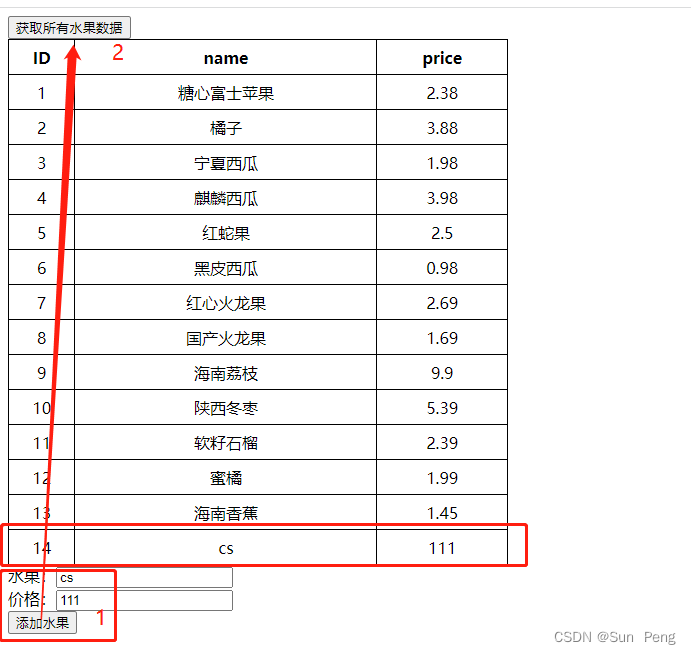
七、更新数据:PUT 方法,常用来更新已有资源,若资源不存在,它也会进行创建。
案例:输入水果对应id,修改其价格。
<p>更新水果价格</p>
水果id:<input id="putId" type="text" name="fruitId"><br>
价格:<input id="putPrice" type="text" name="fruitPrice"><br>
<button id="putBtn">put更新</button>
$("#putBtn").click(function () {
$.ajax({
type: 'put',
url: 'http://localhost:3004/fruits/' + $("#putId").val(),
data: {
price: $("#putPrice").val()
},
success: function (data) {
console.log("put success")
},
error: function () {
alert("put error")
}
})
})
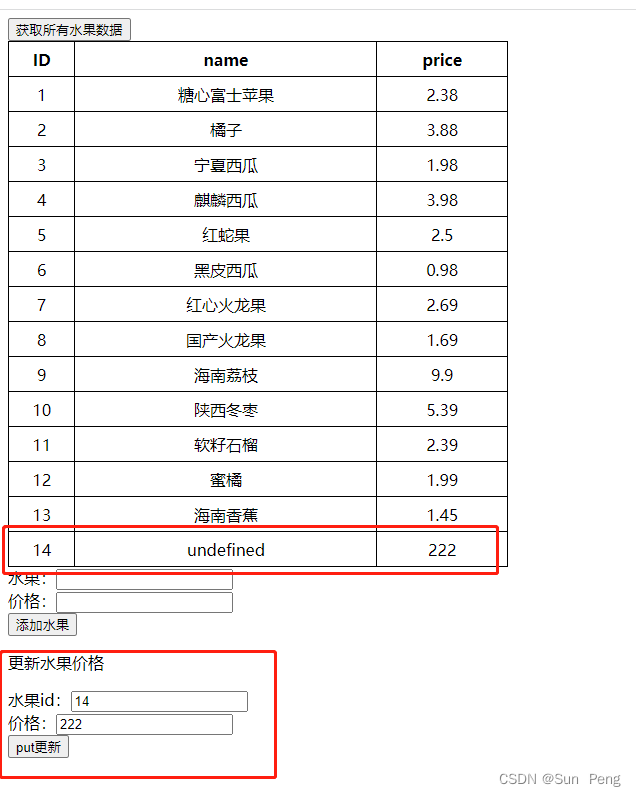
这是因为,
PUT方法会更新整个资源对象,前端没有给出的字段,会自动清空。所以,要么我们在ajax的data中给出完整的对象信息,要么采用PATCH方法。PATCH是一个新方法,可以当作是PUT方法的补充,主要用来做局部更新。
案例:同PUT方法。
$("#putBtn").click(function () {
$.ajax({
type: 'patch',
url: 'http://localhost:3004/fruits/' + $("#putId").val(),
data: {
price: $("#putPrice").val()
},
success: function (data) {
console.log("put success")
},
error: function () {
alert("put error")
}
})
})
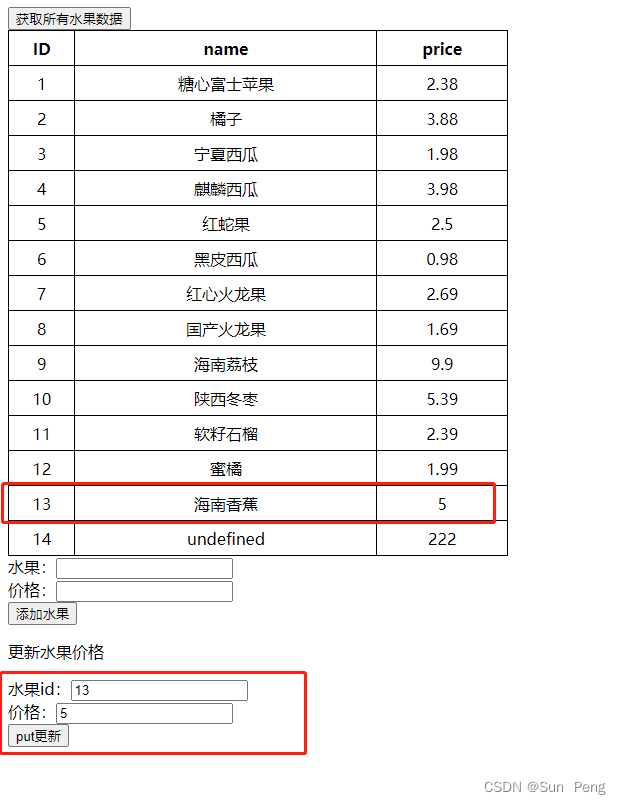
但有时候,我们更希望能通过输入水果名称,来动态更新水果价格。但 ‘http://localhost:3004/fruits/橘子’ 这种 url 是错误的,而像 ‘http://localhost:3004/fruits?name = 橘子’ 这种url,只能供 GET 方法来获取数据。既然如此,我们就多绕个弯,通过GET方法来获知id,然后再通过id去PATCH数据。
实现方法如下:
<p>通过水果名更新水果价格</p>
水果:<input id="editName" type="text" name="fruitName"><br>
价格:<input id="editPrice" type="text" name="fruitPrice"><br>
<button id="editBtn">edit</button>
$("#editBtn").click(function () {
getFun($("#editName").val(), patchFun)
})
function getFun(name, f) {
$.ajax({
type: 'get',
url: 'http://localhost:3004/fruits' + '?name=' + name,
success: function (data) {
// data 对象数组
console.log(data[0]);
if (typeof f == "function") f.call(this, data[0].id)
},
error: function () {
alert("error")
}
})
}
function patchFun(id) {
$.ajax({
type: 'patch',
url: 'http://localhost:3004/fruits/' + id,
data: {
price: $("#editPrice").val()
},
success: function (data) {
console.log("success", data)
},
error: function () {
alert("error")
}
})
}
八、删除数据: DELETE 方法,常用来删除已有资源
案例:根据id删除水果数据
<p>删除水果</p>
水果id:<input id="delId" type="text" name="delName"><br>
<button id="delOne">根据id删除</button>
<button id="delAll">删除所有</button>
$("#delOne").click(function () {
$.ajax({
type: 'delete',
url: 'http://localhost:3004/fruits/' + $("#delId").val(),
success: function (data) {
console.log("del success")
},
error: function () {
alert("del error")
}
})
})
若想用删除全部,没办法使用’http://localhost:3004/fruits’ 这种请求url。因为必须指定删除的对象id。所以只能通过循环删除。这就需要实现通过GET方法来获取当前最大id(注意是最大id,而不是数据个数)来作为循环的边界。
$("#delAll").click(function () {
// 此处就没有动态去获取db.json中fruits的最大id,直接带入10
for (var i = 0; i <= 10; i++) {
delFun(i)
}
})
function delFun(id) {
$.ajax({
type: 'delete',
url: 'http://localhost:3004/fruits/' + id,
data: '',
success: function (data) {
console.log("del success", data)
},
error: function () {
console.log("del error")
}
})
}
九、配置静态资源服务器:主要是用来配置图片、音频、视频资源
通过命令行配置路由、数据文件、监控等会让命令变的很长,而且容易敲错;
json-server允许我们把所有的配置放到一个配置文件中,这个配置文件一般命名为json_sever_config.json;
【1】json_sever_config.json
{
"port": 3004,
"watch": true,
"static": "./public",
"read-only": false,
"no-cors": false,
"no-gzip": false
}
【2】package.json
{
"scripts": {
"mock": "json-server --c json_sever_config.json db.json"
}
}
我们可以把我们的图片资源都放在public目录中,但是public目录不仅可以放图片,也可以放音频和视频,所有大家放资源的时候,在public下面创建images用来放置图片,创建audio/video分别放置音频和视频;
既然我们已经在json_server_config.json里面指明了静态文件的目录,那么我们访问的时候,就可以忽略public;
图片:http://localhost:3004/图片名称

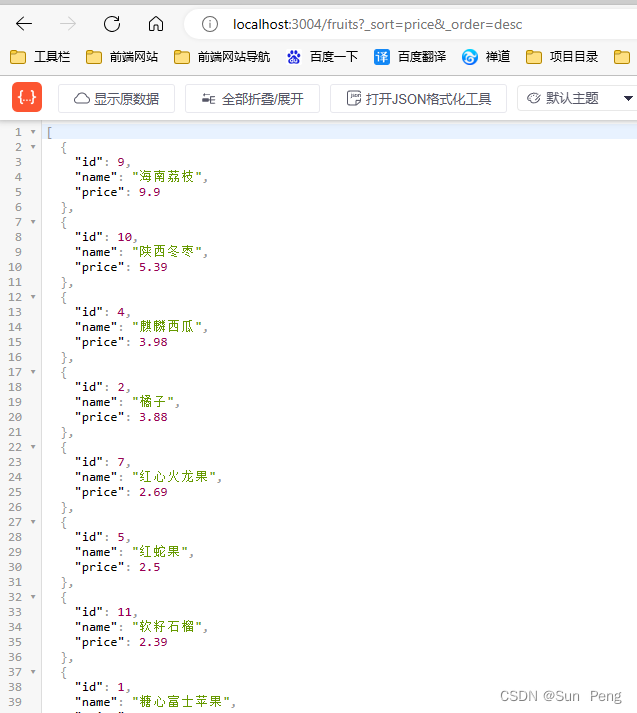
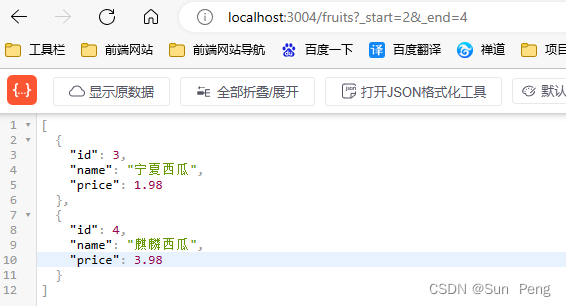
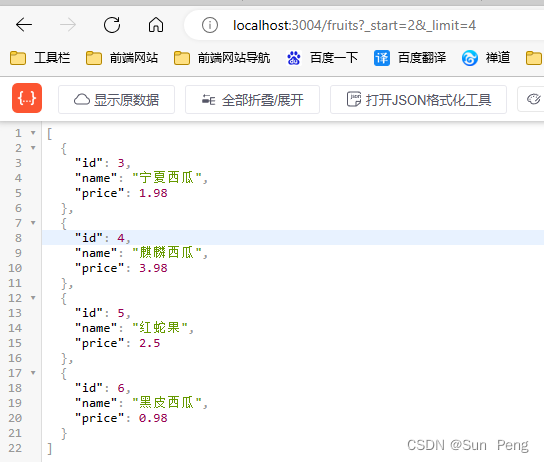
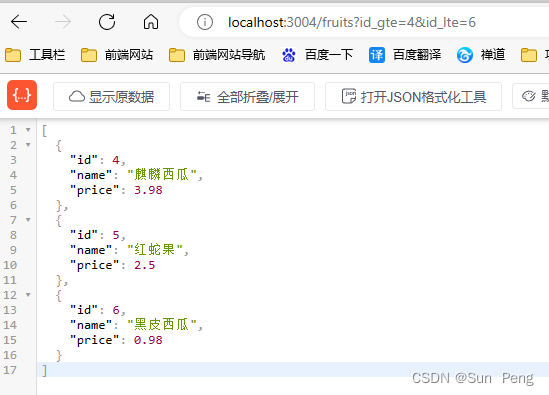
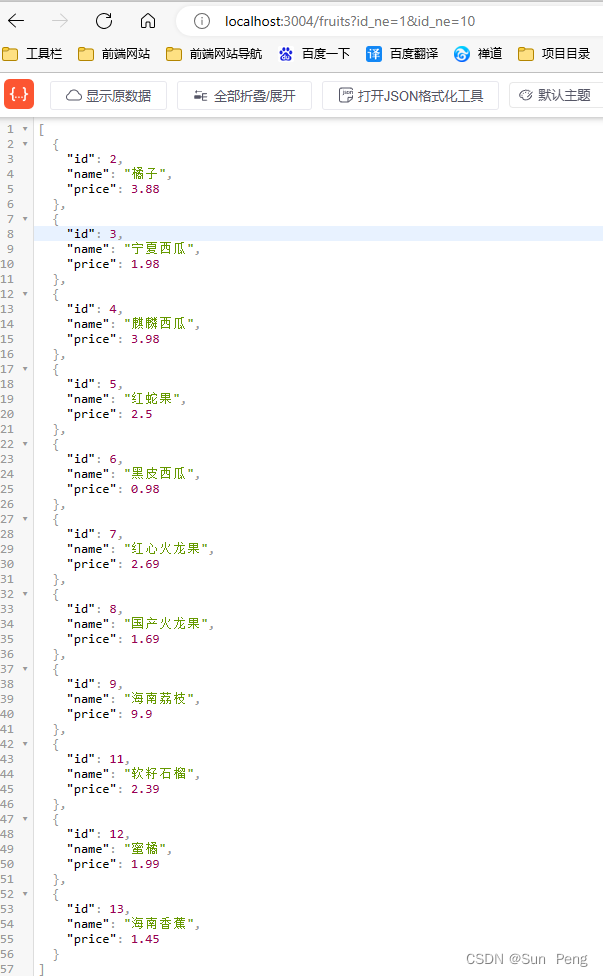
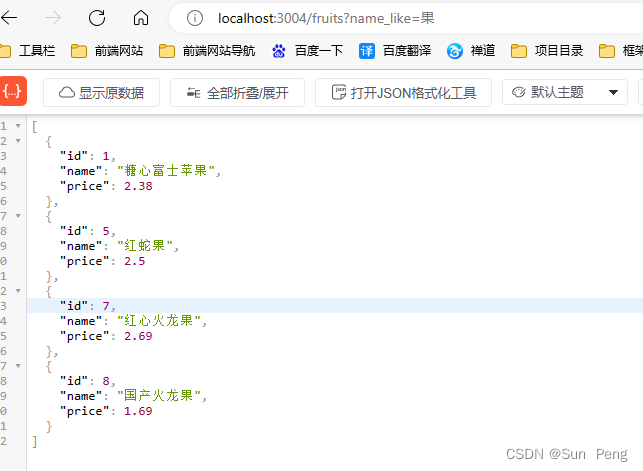
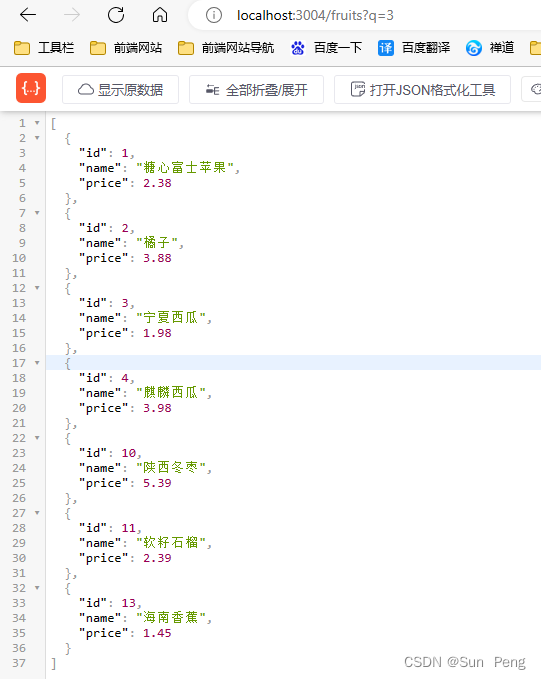
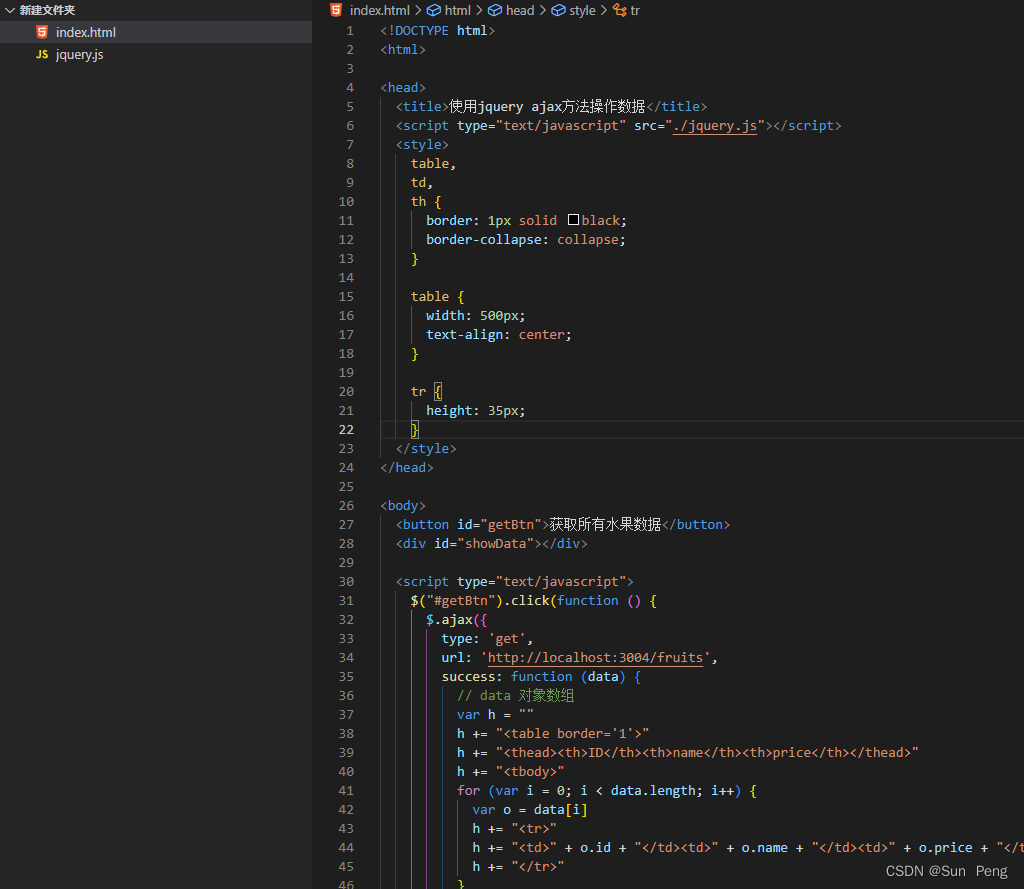


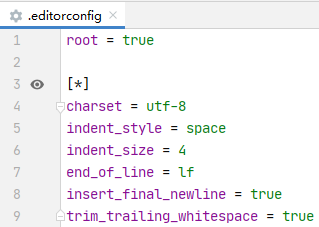


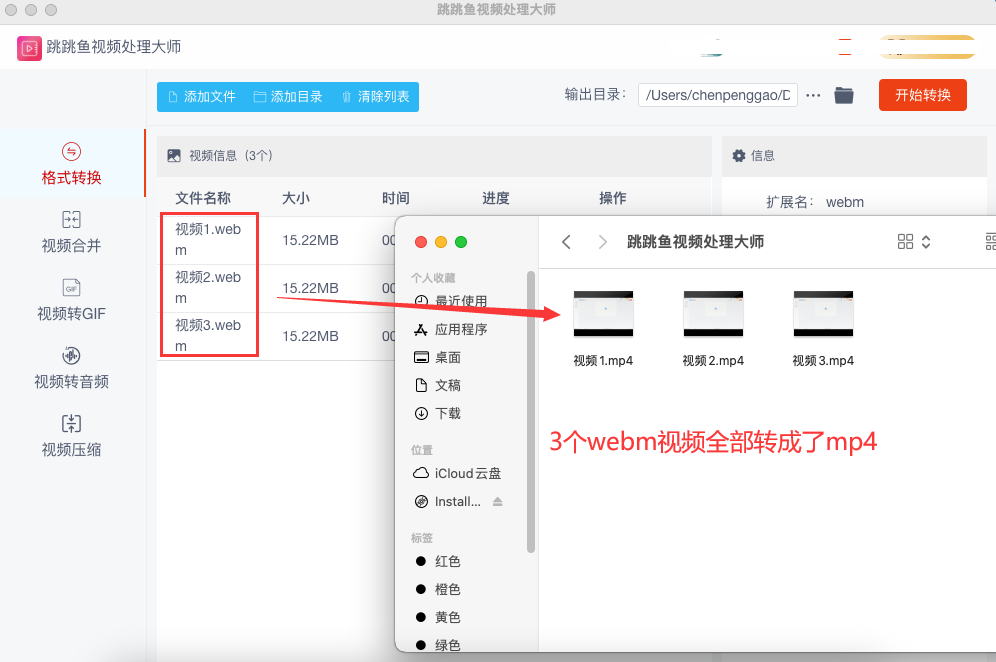
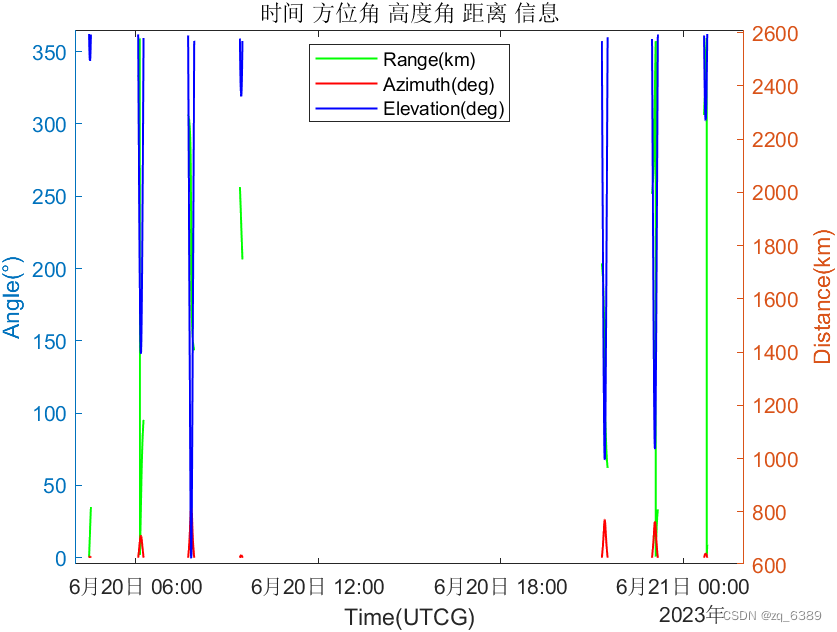
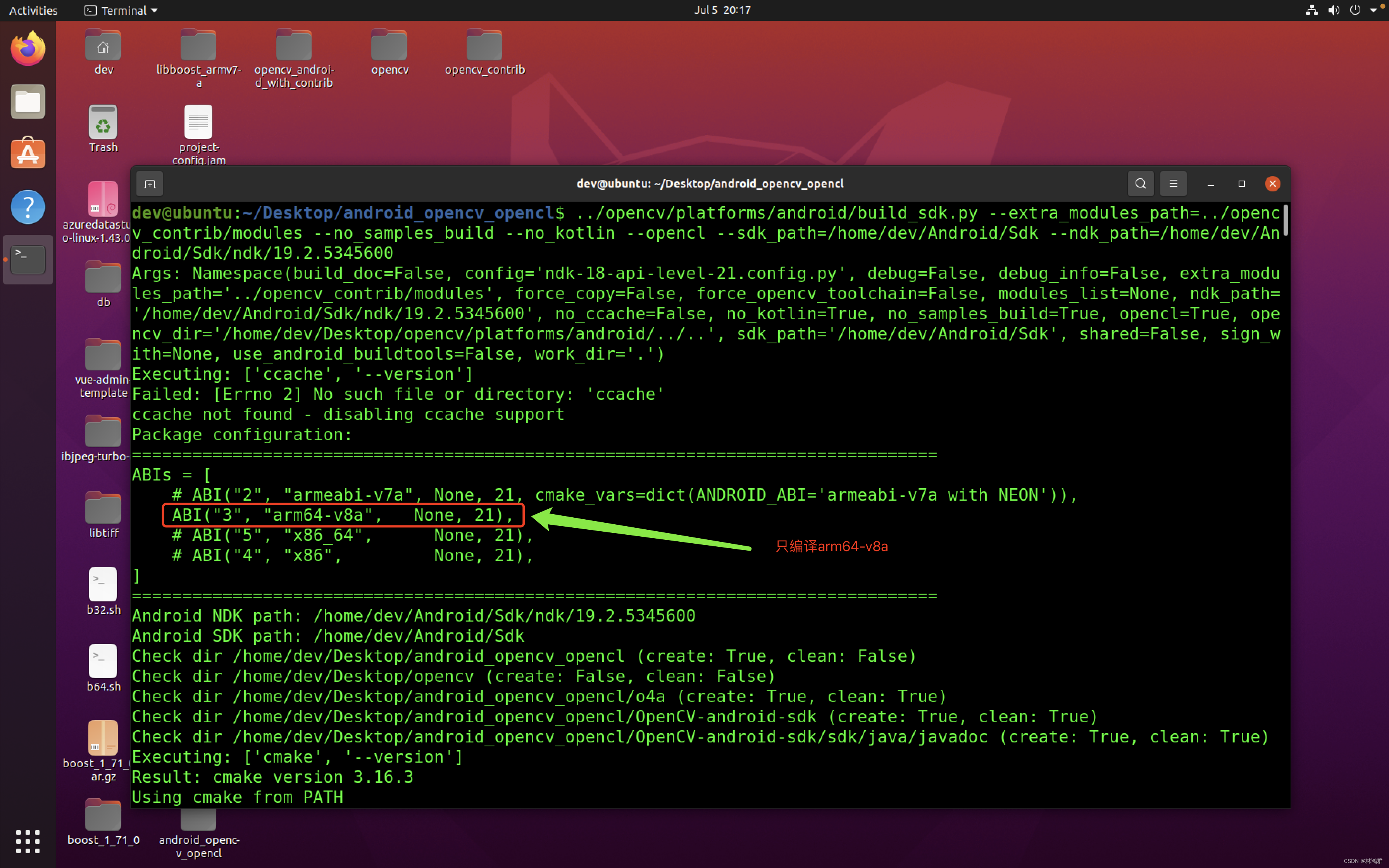

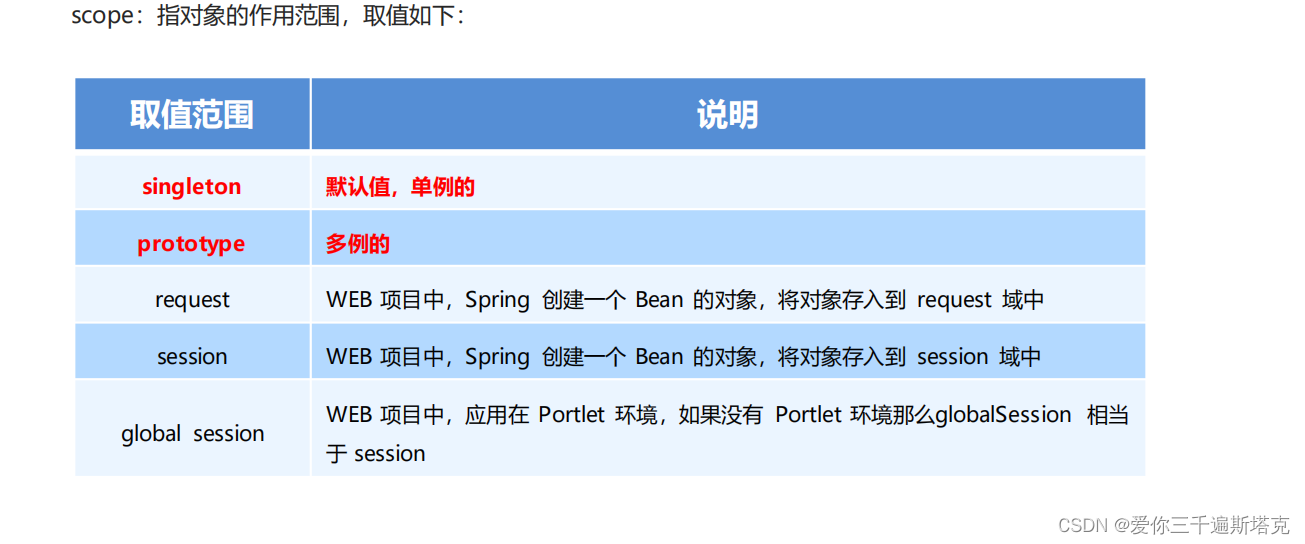


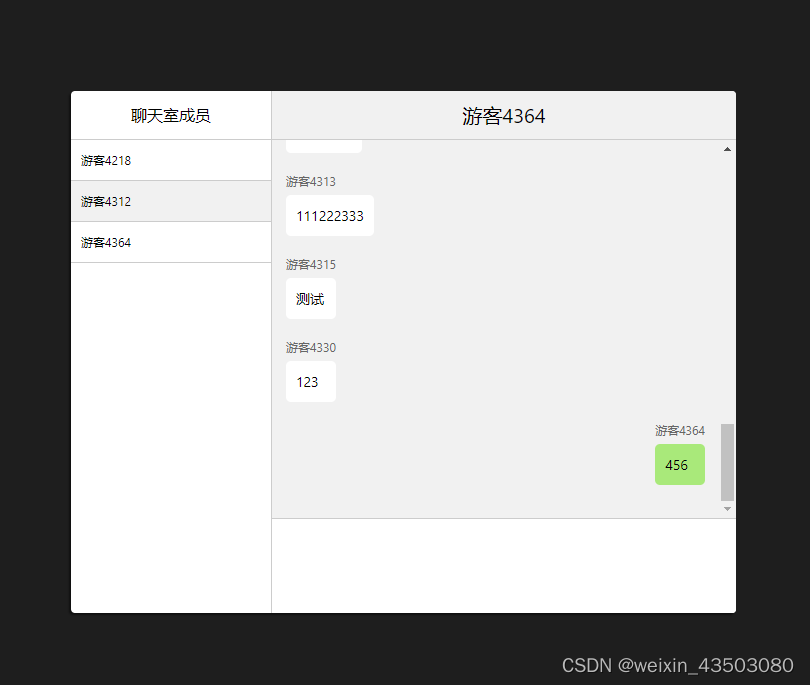
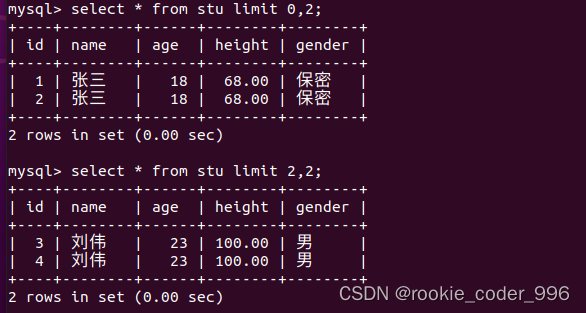
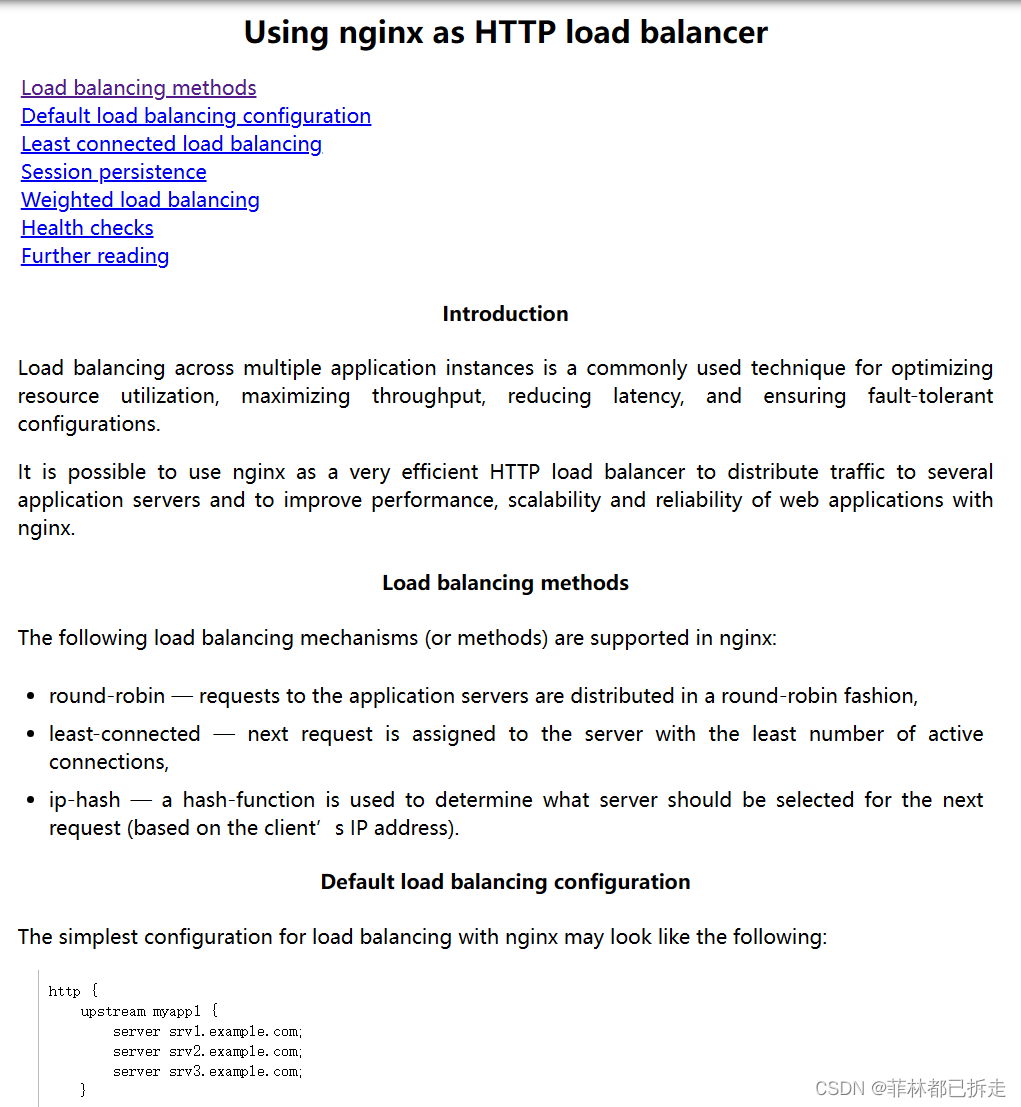
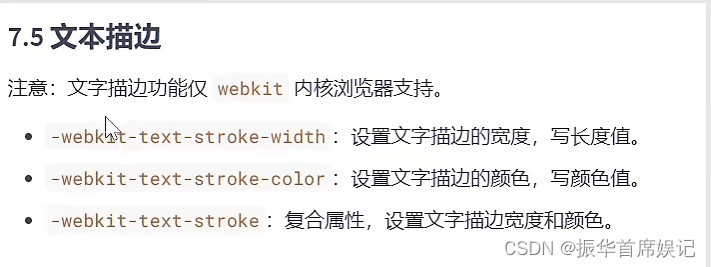

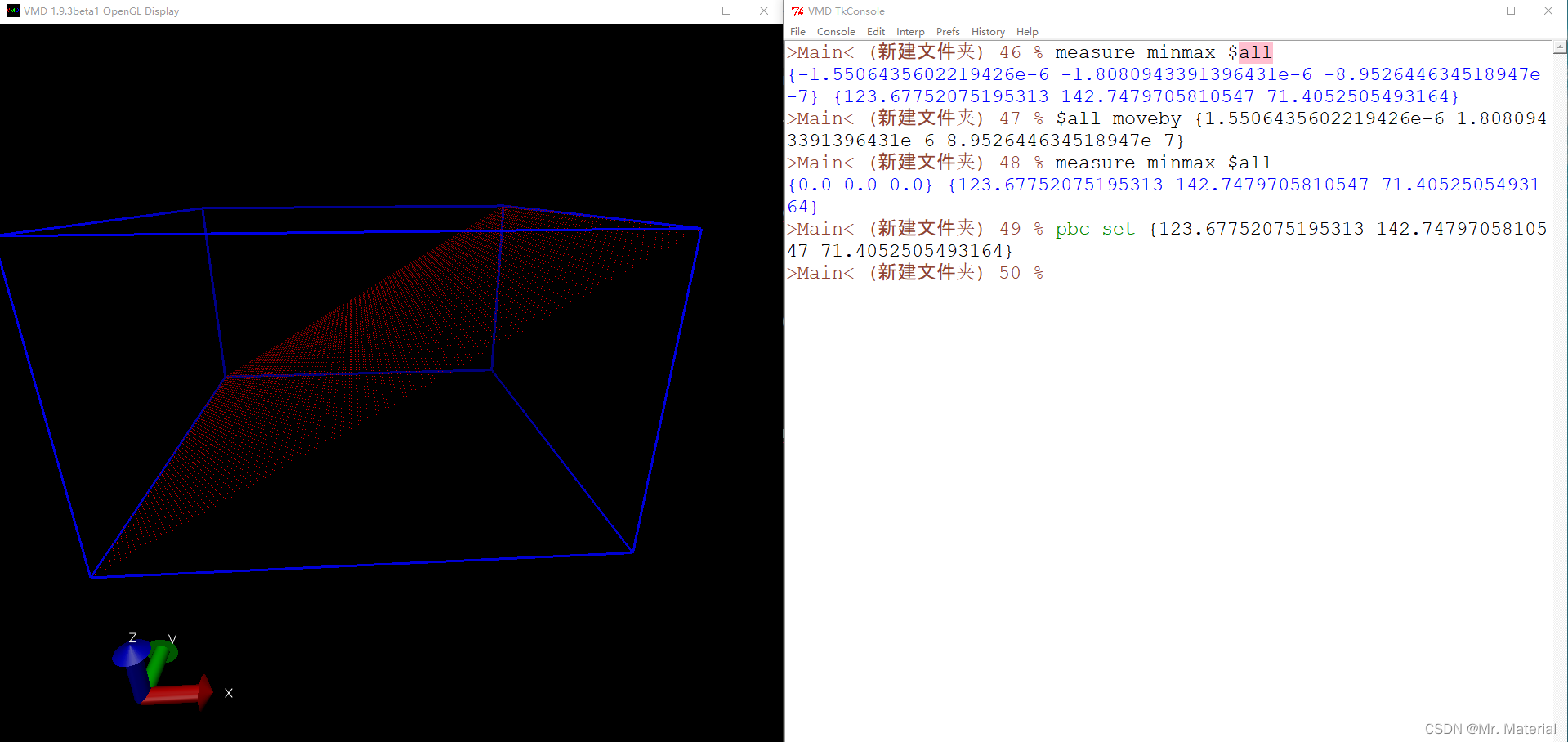

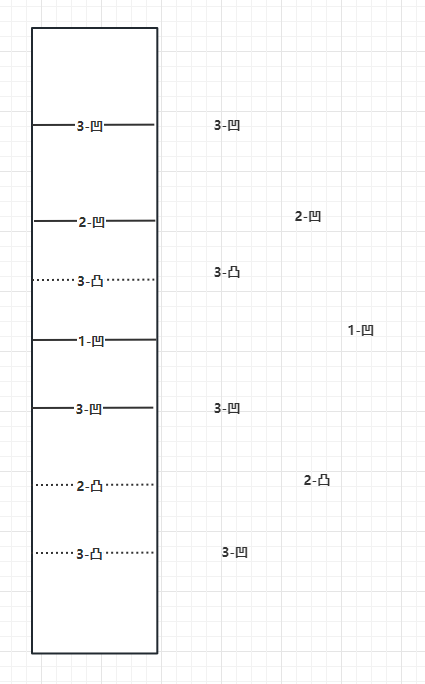
![CodeForces..碰撞字符.[简单].[遍历求最大连续]](https://img-blog.csdnimg.cn/f694566aa1e94d7bab641179d5d31d29.png)
